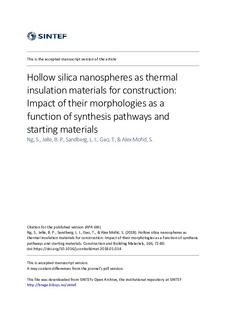Hollow Silica Nanospheres as Thermal Insulation Materials for Construction: Impact of their Morphologies as a Function of Synthesis Pathways and Starting Materials
Journal article, Peer reviewed
Accepted version
Permanent lenke
http://hdl.handle.net/11250/2495462Utgivelsesdato
2018Metadata
Vis full innførselSamlinger
- Publikasjoner fra CRIStin - SINTEF AS [5802]
- SINTEF Community [2248]
Originalversjon
Construction and Building Materials. 2018, 166 72-80. 10.1016/j.conbuildmat.2018.01.054Sammendrag
Hollow silica nanospheres (HSNS) show a promising potential to become good thermal insulators with low thermal conductivity values for construction purposes. The thermal conductivity of HSNSs is dependent on their structural features such as sizes (inner diameter and shell thickness) and shell structures (porous or dense), which are affected by the synthetic methods and procedures including reaction medium, polystyrene template, and silica precursor. Formation of thermally insulating HSNS was favoured by alkaline reaction, whereby highly porous silica shells were formed, promoting less silica per volume of material, thus a lower solid state thermal conductivity. The Knudsen effect is in general reducing the gas thermal conductivity including the gas and pore wall interaction for materials with pore diameters in the nanometer range, which is also valid for our HSNS reported here. Further decreasing the pore sizes would invoke a higher impact from the Knudsen effect. The additional insulating effect of the inter-silica voids (median diameter D50 ≈ 15 nm) within the shell coating contributed also to the insulating properties of HSNS. The synthesis route with tetraethyl orthosilicate (TEOS) was more robust and produced more porous silica shells than the one with water glass (Na2SiO3, WG), although the latter might represent a greener synthetic method
